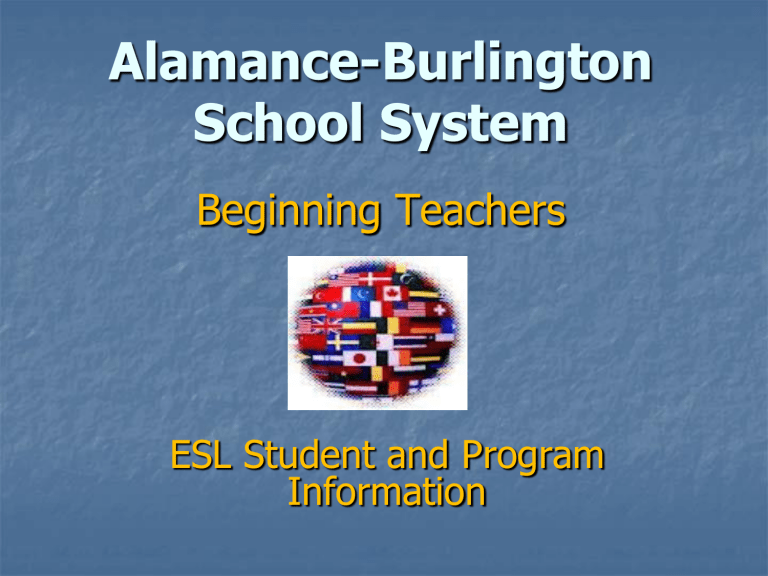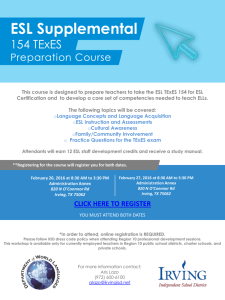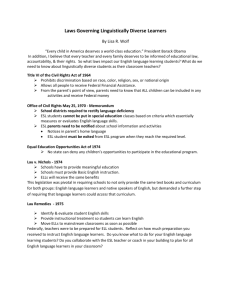Burning Questions

Alamance-Burlington
School System
Beginning Teachers
ESL Student and Program
Information
Burning Questions
Some things to think about…..
ESL program
English Language Learners
(ELLs)
Curriculum
State testing
2
Understanding Second Language
Terminology
ESL – English as a Second Language
ESOL – English for Speakers of Other
Languages
ELL – English Language Learner
LEP – Limited English Proficient
3
North Carolina ELLs by Language
2009-2010
Spanish 123,841
Chinese 3,761
Hmong 3,622
Vietnamese 2,530
Arabic 2,331
Korean 1,731
French 1,478
Russian 1,259
Hindi 1,074
Gujarati 808
4
Your LEPS
Eastlawn
191 LEPs Projected, 3 ESL Teachers
Haw River
181 LEPs Projected, 3.5 ESL Teachers
North Graham
85 LEPs Projected, 2 ESL Teachers
South Graham
161 LEPs Projected, 3 ESL Teachers
Graham Middle
107 LEPs Projected, 2 ESL Teachers
5
What kind of Support can you get for these LEPs?
Collaboration with ESL Teachers
Co-teaching and Co-planning
ESL Professional Development
ABSS Professional Development integrating ESL Student Needs
ESL Pull-out by ESL Teachers
Some Interpreting/Translating Support
6
Negative Manifestations of
Culture Shock
Elementary Student
Crying
Refusing to go to school
Bed wetting
Stomach aches
Falling behind
Nightmares
Frequent visits to health room
Elective mutism
7
Time Spans for Language
Acquisition
Native English
Speakers
English
Language Learners
1 to 3 years
7 to 10 years
BICS
Social Language
CALP
Academic Language
Source: James Cummins (1984) and Virginia Collier (1987)
8
Social vs. Academic
Language
Social Language Academic Language
Open the door, please.
Would you like to get a coke?
At what time do we go home?
Tell me what you liked about the movie.
Do you want to play?
Define mammal.
Compare and contrast
Saturn and Jupiter.
Paraphrase the paragraph.
What is the main idea of this paragraph?
Write a summary for your story.
9
Social vs. Academic
Language
Social Language Academic Language
Simpler language.
Technical vocabulary.
Usually face-to-face, small number of people, informal setting.
Precise understanding is seldom required.
Many opportunities to clarify.
Often lecture-style communication or reading a textbook; little situational context.
Precise understanding and precise explanation is required.
More difficult to clarify.
10
Self-Esteem
Age
Attitudes
And
Motivation
Anxiety
FACTORS
AFFECTING
SECOND
LANGUAGE
ACQUISITION
Native
Language
11
Circle of Friends
Circulo de Amigos
12
WIDA Standards
Standard 1: English Language Learners communicate for
Social and Instructional purposes within the school setting.
Standard 2: ELLs communicate information, ideas, and concepts necessary for academic success in the content area of Language Arts .
Standard 3: ELLs communicate information, ideas, and concepts necessary for academic success in the content area of Mathematics .
Standard 4: ELLs communicate information, ideas, and concepts necessary for academic success in the content area of Science .
Standard 5: ELLs communicate information, ideas, and concepts necessary for academic success in the content area of Social Studies .
13
Stages of Language Acquisition
WIDA Language Proficiency Levels
Entering – Level 1
Beginning – Level 2
Developing – Level 3
Expanding – Level 4
Bridging – Level 5
Reaching – Level 6
14
Other ESL Resources
Can Do Descriptors
LEP Accommodation Forms
ACCESS Teacher Reports
ESL Best Practices Handout
15
ACCESS Teacher Report
16
ACCESS Teacher Report
17
Burning Questions
Some things to think about…..
ESL program
English Language Learners
(ELLs)
Curriculum
State testing
Need more information?
18
For More Information:
Your ESL teacher is your best friend!
Carlos Oliveira , ESL Coordinator
516-2018 carlos_oliveira@abss.k12.nc.us
Michele Woodson , Director of Instructional
Improvement & ESL michele_woodson@abss.k12.nc.us
19



